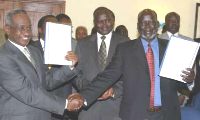Khartoum, main rebels open way to sign final peace agreement
NAIROBI, Dec 30 (AFP) — Khartoum and the main southern rebel group agreed on the last issues in their lengthy peace talks in Kenya, paving the way to signing a comprehensive peace deal to end Africa’s longest-running conflict.

|
|
Sudanese Vice president Ali Osman Mohamed Taha (L), SPLM leader John Garang show the signed agreement on Wealth Sharing in Nivasha with general Lazaro in the middle, January 7, 2004. (AFP). |
The way was opened after Sudan’s Vice President Ali Osman Taha and Sudan People’s Liberation Movement/Army (SPLM/A) leader John Garang agreed on a permanent ceasefire and on details how the final peace agreement would be implemented.
“They have finally agreed on the ceasefire and implementation modalities,” of the main peace agreement, an official in the mediation told AFP by telephone from the talks’ venue in the northwestern Kenyan town of Naivasha.
An AFP correspondent overheard Sudanese President Omar al-Beshir telling his visiting South African counterpart, Thabo Mbeki, in Khartoum that: “You have come with the signs of peace … the peace agreement will be signed tomorrow.”
A Kenyan foreign ministry official said the two protocols will be signed in Naivasha on Friday. An official in the mediation and SPLM/A spokesman Yasser Arman told AFP that a final peace agreement will be signed on January 9 in Nairobi.
“Friday’s signing is going to mark the end of negotiations and the finalization of the peace agreement,” Arman told AFP. Chief mediator Lazaro Sumbeiywo, a retired Kenyan army general, confirmed.
A permanent ceasefire will, however, enter into force on the day a final peace deal will be signed.
As the news reached Khartoum, dozens of southern Sudanese marched along streets of Khartoum chanting greetings to Garang, referring to his planned taking over of the vice presidency in Africa’s largest nation, once implementation gets underway, the AFP correspondent reported.
“Welcome the New Sudan … welcome John Garang,” as some 70 chanting southerners were seen moving along the main Khartoum avenues carrying a portrait of Garang, a balding US educated economist, who has led the southern rebellion since 1983.
The latest agreements mark the end of sticking points in the peace talks, which started in Kenya in early 2002, and pave the way for the drafting and eventually signing of a peace agreement to end 21 years of fighting in southern Sudan.
The two sides pledged last month in writing before the UN Security Council to sign a final peace deal by year-end.
Since July 2002, both sides have managed to agree on protocols on granting the south the right to self determination after six years of self-rule, power and wealth-sharing, management of national security and administration of disputed regions in the centre of the country during the post-conflict interim period.
The countdown to six years of the south’s self rule starts six months from the day it is signed.
US President George W. Bush, in a message to al-Beshir, said clinching and ending the fighting would thaw relations between the two nations, which have nosedived owing to a new war in Sudan’s western Darfur region, as well as Khartoum’s alleged support for terrorism.
“We hope that the imminent signing of the peace agreement in Naivasha will be an incentive to reach peace all over Sudan and a basis for firm ties between our two peoples,” Bush said in the message, broadcast by official Sudan News Agency (SUNA).
The Sudan war erupted in 1983 when the southern rebels rose up against Khartoum to end Arab and Muslim domination and marginalisation of the black, animist and Christian south.
The war and its effects have killed at least 1.5 million people and displaced four million others in the former British colony that got its independence in 1956.
As the permanent stability is set to resume in the south, fighting continues to rage in Darfur, where tens of thousands of people have been killed and 1.6 million others displaced in the 22 months of clashes, despite the presence of a ceasefire.
